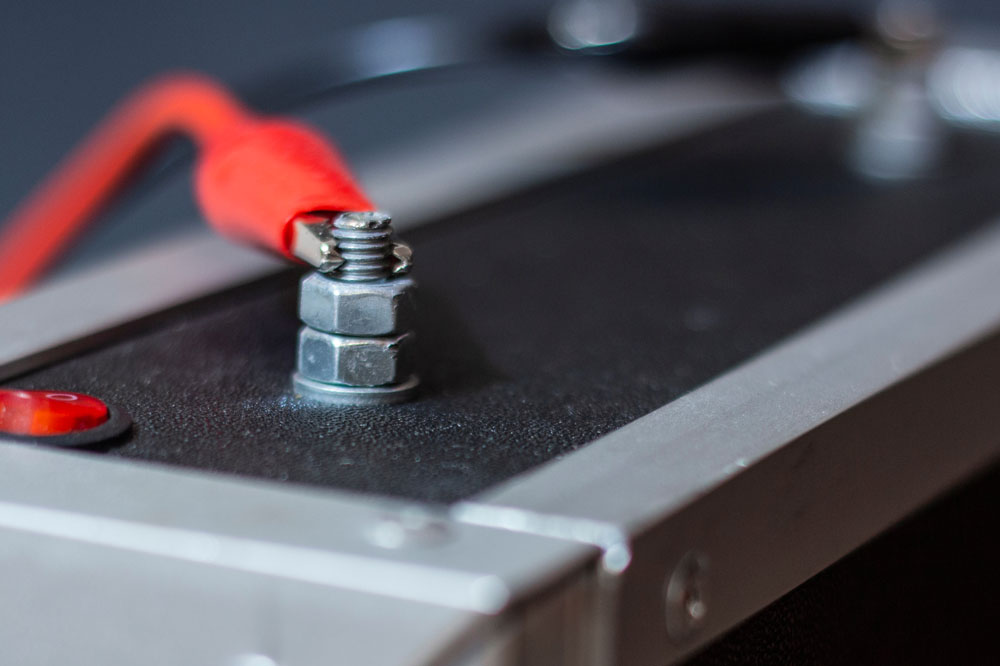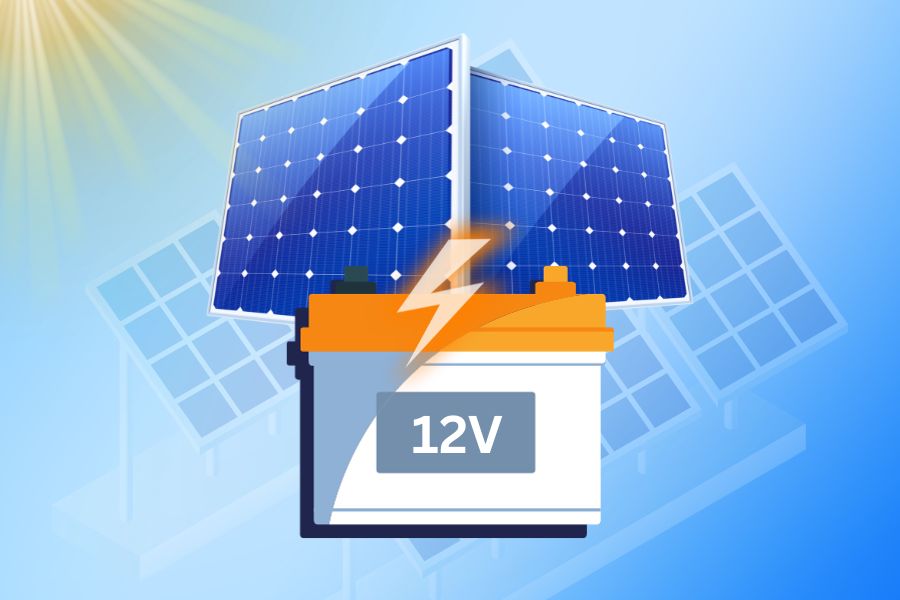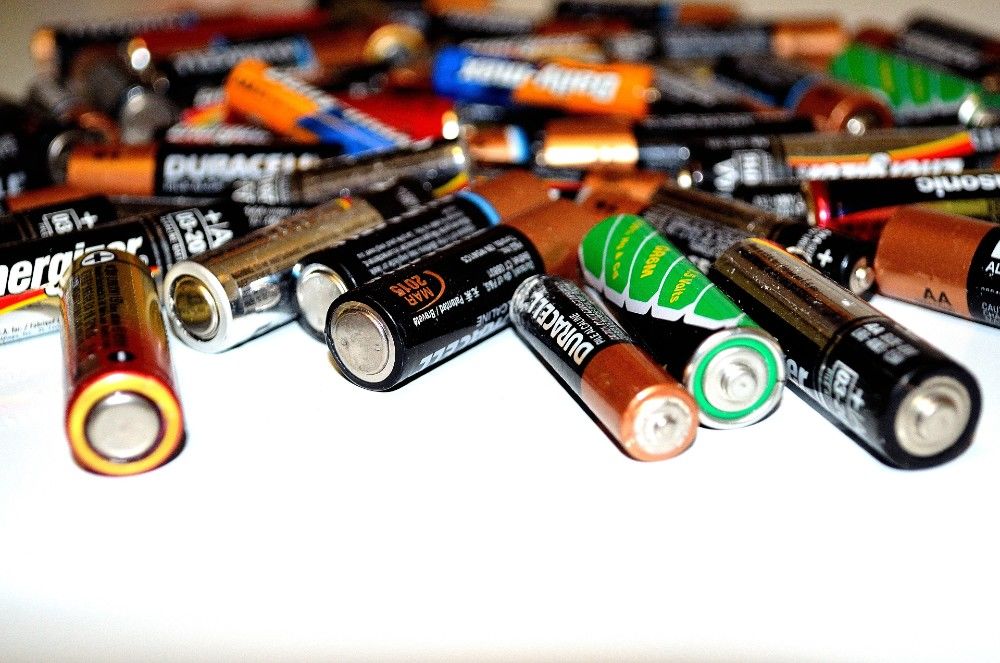What Size Solar Panel to Charge 100Ah Battery?
Updated:

Determining the right solar panel size to charge a 100Ah battery involves considering several key factors, including the battery voltage, battery’s capacity, battery type (lead-acid vs lithium-ion), how much you deplete the battery each day, the solar charge controller used, and the amount of sun your location receives.
In this guide, we’ll cover all the factors that affect the required solar panel size for charging 100Ah batteries.
Calculating Solar Panel Size for 100Ah Battery

Our solar panel size calculator combines all the steps required to determine the wattage of solar panels needed for your battery.
Let’s see how you can easily find out what size solar panel is needed to charge a 100Ah battery.
Step 1: Input Battery Voltage
Field to Fill: Battery Voltage (usually in Volts)
The battery voltage is essential because the solar panel voltage should at least match it. Check your battery specifications for the voltage rating. It’s usually printed on the battery label.
If you are using more than one battery connected together, multiply the voltage of a single battery by the number of batteries connected in series.
Step 2: Input Battery Amp-Hours
Field to Fill: Battery Amp Hours (Ah)
Ampere-hours (Ah) represent the battery capacity, indicating how much charge your 100Ah battery needs for a full charge. Larger capacities require larger solar arrays to charge within a given time frame.
If you’re using a 100Ah battery, simply input “100” into this field.
Step 3: Choose Battery Type
Field to Fill: Battery Type
Battery types like Lithium (LiFePO4) or Lead Acid have different charging characteristics. Refer to your battery specifications. The type is usually indicated on the battery label or user manual.
Step 4: Input Depth of Discharge (DoD)
Field to Fill: Battery Depth of Discharge (DoD)
DoD is a percentage that shows how much of the total battery capacity has been discharged. Check your battery’s manufacturer guidelines for recommended DoD values.
For Lead Acid, it’s often around 50%, and for Lithium, it can go up to 80-100%.
Step 5: Select Solar Charge Controller Type
Field to Fill: Solar Charge Controller Type
The two main types are MPPT and PWM. MPPT is more efficient, generally requiring a smaller solar array size compared to PWM for the same battery.
Choose this based on your system needs. For smaller setups, PWM might be adequate. For larger or more complex systems, MPPT is usually better.
Step 6: Input Desired Charge Time
Field to Fill: Desired Charge Time (in peak sun hours)
This is when you want the battery to be fully charged, given in peak sun hours. Shorter charge times will require larger solar arrays. If you want to fully recharge your battery every day, input the average daily peak sun hours for your location.
You can do this using solar maps or local meteorological data. For a more exact value for your location, use our peak sun hours calculator to estimate the average daily PSH for your system’s location, panel tilt, and orientation.

Step 7: Calculate the Solar Panel Size
Once you click the “Calculate” button, the calculator uses the data to estimate the required solar panel size in watts.
Once done, it outputs the minimum solar panel wattage required to recharge the battery in that timeframe.

For the example data in the figure above, a 280W solar panel will be needed to charge a 100Ah battery in 5 peak sun hours.
If you have smaller solar panels available, you will need multiple solar panels to charge the battery.
To calculate how many solar panels you need, divide the calculated solar panel required power by the rating of a single PV panel you have available. For example, if you have 100W solar panels, then:
\(Number\ of\ solar\ panels\ needed = \displaystyle {\frac {280}{100}} = 2.8 \approx 3\)
Number of solar panels needed = 280 ÷ 100 = 2.8 ≈ 3
So, you will need 3 solar panels to charge a 100Ah battery.
How Is the Solar Panel Size Calculated?
Determining the proper solar panel size for your 100 amp-hours battery involves several key steps.
Let’s look at each step of solar panel sizing for battery charging in detail.
Calculating the Daily Battery Energy Usage
First, we estimate how much energy your loads and appliances use from the battery each day. This daily energy draw determines how much energy your solar panels need to replace or offset.
Energy is commonly measured in watt-hours (Wh) or kilowatt-hours (kWh). The calculator calculates your battery’s total energy capacity using the following formula:
\(Battery\ Energy\ Capacity\ (Wh) = Battery\ Voltage\ (V) * Capacity\ (Ah)\)
For example, a 12V 100Ah battery would have an energy capacity of:
\(12V * 100Ah = 1200\ Wh\)
Adding the Effect of Depth-of-Discharge and System Efficiency
Next, we account for the depth of discharge which controls how much the battery is allowed to deplete. This will depend on the type of battery you use:
- Lead-Acid – Only use 50% of capacity to prolong life. Charge slower than lithium-ion.
- Lithium-Ion – Can utilize up to 100% of capacity. Charge rapidly with higher voltages.
For lead-acid battery capacity, only use 50% of your battery’s capacity for solar system sizing. Due to this, lead-acid batteries require smaller solar panels than lithium-ion batteries with the same amp-hour rating.
Lithium batteries, like lithium iron phosphate batteries, can be discharged deeper and charged faster. However, the increased solar panel voltage required for rapid charging must be compatible with your charge controller.
Next, we account for the efficiency losses between the solar panels and the battery. This depends on the type of solar charge controller type used:
- PWM Solar Charge Controller: 75-80% efficient
- MPPT Solar Charge Controller: 92-98% efficient
To calculate the actual required daily production of solar panels, we use:
\(Daily\ Solar\ Energy\ Needed\ (Wh) = \displaystyle {\frac {Battery\ Energy\ Used\ per\ Day\ (Wh) * DoD}{Solar\ Charge\ Controller\ Efficiency\ (\%)}}\)
Here is an example calculation with an MPPT controller (98% efficient) and a 1200 Wh Li-ion battery (with a depth-of-discharge of 90%):
\(Daily\ Solar\ Energy\ Needed = \displaystyle {\frac {1200Wh * 0.9}{0.98}} = 1100\ Wh\)
By factoring in efficiency, we ensure your solar panels produce enough surplus energy to fully charge the battery after losses.
Calculating the Required Size of Your Solar Panels
With the known daily energy production requirement (from Step 2) and the average peak sun hours per day at your location, we calculate the solar panel size needed using:
\(Solar\ Panel\ Rating\ (Watts) = \displaystyle {\frac {Daily\ Energy\ Needed\ (Wh)}{Avg.\ Daily\ Peak\ Sun\ Hours}}\)
Let’s say you need 750 Wh per day and have 5 PSH of sunlight. The solar panel rating would be:
\(Solar\ Panel\ Rating = \displaystyle {\frac {1100Wh}{5}} = 220\ Watts\)
Adjusting Solar Panel Size for Real-world Performance
Finally, we add a 20-30% buffer to account for real-world conditions like seasonal solar energy differences and suboptimal weather conditions. So,
\(\textbf {Required Solar Panel Rating = 220 * 1.3 = 286 Watts}\)
This means that around 280-290 watts of solar panels will be enough to charge a 100Ah battery in a day (5 peak sun hours).
While the calculations provide an optimal baseline solar panel size for your 100Ah battery bank, building in flexibility helps ensure your system meets your needs today and in the future.
Recommended Solar Panel Size Examples
Let’s look at some examples of minimum recommended solar panel sizing for 100Ah batteries based on the key factors we’ve covered:
100Ah Lead-Acid Battery
For 5 Peak Sun Hours Per Day with a PWM charge controller,
- Recommended solar system size = 270 W
100Ah Lithium Battery
For 5 Peak Sun Hours Per Day with an MPPT charge controller,
- Recommended solar system size = 310 W
These solar panel sizes provide a buffer for real-world conditions and ensure your 100Ah batteries can be fully recharged daily.
Solar Panel Configurations

If a single solar panel doesn’t meet your wattage requirements, you can wire multiple smaller panels together in parallel and series configurations to reach the total power output needed.
Series Wiring
- Panels wired in series combine voltages while the current remains the same.
- For example, two 12V 100W panels in series produce 24V and 100W.
- Use series wiring to increase the voltage to match the battery bank.
Parallel Wiring
- Panels wired in parallel combine current while voltage remains the same.
- For example, two 12V 100W panels in parallel produce 12V and 200W.
- Use parallel to increase total wattage to match your system requirements.
You can also wire panels in series-parallel combinations to achieve your ideal system voltage and wattage.
Consult the solar panel and charge controller manuals to ensure proper voltage and amperage limits are not exceeded.
Solar Panel Placement Tips
Proper solar panel positioning maximizes power production:
- Face panels south (northern hemisphere) to receive optimal sun exposure.
- Angle panels to match your latitude for maximum year-round energy collection.
- Inclining panels 15 to 30 degrees typically works well for battery charging.
- Keep panels clean and clear of shade to maintain output.
- For portable kits, adjust panel direction hourly to track sunlight.
- Use pole/roof mounts allowing seasonal tilt adjustment.
- Separate stationary arrays into east/west facing rows to collect morning/afternoon sun.
To calculate the best angle to tilt your solar panels, use our solar panel tilt angle calculator.

Maintaining and Troubleshooting Your System
With your properly sized solar array charging your 100Ah battery bank, here are some maintenance best practices:
- Inspect wiring connections periodically for loosening.
- Check the charge controller display for system status and battery state of charge.
- Ensure panels are clean – dusty panels produce less power.
- Verify panels have proper tilt and sun exposure throughout the year.
- Check batteries for corrosion or leaks quarterly. Distilled water may need to be added to flooded lead acid batteries periodically.
- Equalize charge flooded batteries every 6 months.
- Watch for signs of under or overcharging based on battery voltage.
Proper solar power system maintenance keeps your batteries operating efficiently for years.






